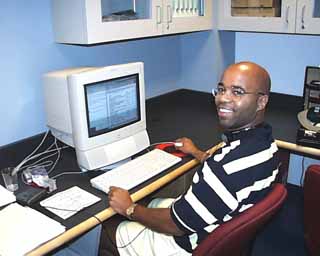�
GEOL/WEB

GEOLOGY UNIT
The science of geology provides an excellent linkage between paleontology and the fascinating areas of seismology and volcanology. One could conclude his or her discussion of paleontology by posing the question of why have similar fossil remains of dinosaurs been found on more than one continent. The explanation must take into account that, as a means of animal classification, dinosaurs did not swim. So there you are, now begin geology!
As a frame of reference, meeting the following objectives can be used to guide students through this computer assisted activity:
- explain how the Plate Tectonic Theory accounts for current continent location
- recognize that continents are simply the upper portions of plates that lie above sea level
- discuss the relationship between the temperature differences of the Earth's layers and the Plate Tectonic Theory
- handle conversions of kilometers and miles
- in general terms, describe the four types of plate movement
- diagram each stage of mountain formation
- distinguish between a mountain and a hill
- explain why oceanic fossils can be found on mountains above sea level
- use temperature lapse rate as a means for estimating the temperature at the summit or peak of a mountain
- diagram each stage of volcano formation
- make a full color drawing of a volcano illustrating all relavant geological features
- discuss the work of archaeologist
- list two important facts about the rate and location of worldwide volcanic eruptions
- discuss different beliefs held by various ethnic groups regarding volcanic activity
- explain how the NASA designed Dante device has advanced volcanic study
- write an article review of "Robot Explores Steaming Volcano" Current Science 11-4-94
- provide a historical perspective on a volcanic eruption--assigned for research
- discuss geological information about Mount Kilauea
- discuss geological information about Mount St. Helens
STUDENTS BEGIN HERE
Have you ever been to an amusement park? Did you like the rides? I bet you liked the fast ones. Well, there is nothing wrong with that. Believe it or not, you are on a ride right now! You're cruising along at about 5 cm per year! Having any fun? It's true, the continent that we live on has been been cruising along at this rate for the last 250 million years. Actually, our continent lies on an even more massive land mass called The North American Plate. So I ask you, what could be causing these massive plates to move?
POSSIBILITIES
Continental Claustrophobia
http://www.cultures.com/greek_resources/greek_encyclopedia/greek_entry.html/atlas_e.htmlAtlas Shifting the Earth on His Shoulders
The Plate Tectonic Theory
Pretty simple stuff, right? Now, let's really put your "GeoBrain" to work! These tectonic plates primarily move in four different ways. Which do you want to learn about first?
Plate Collision: one forced under
(sample diagram)
Plate Collision: one forced upward
Plates Grinding Against Plates
Plates Moving Apart
You know, this plate movement stuff is really fascinating. I bet you particularly liked that information on volcano formation. How could you not? Hey, do you know anything about the last major eruption on the continental United States? No?! Well, check this out:
BECOMING A MOUNT ST. HELENS EXPERT
Animated View of Eruption
After Eruption
Narrative of Mount St. Helens' Eruption
ONE MORE THING!
If you think Mount St. Helens is impressive, take a look at Mount Kilauea in Hawaii. It is the world's most active volcano, and it is in the United States. Our country rules! Don't forget to take a look at how volcanologists use Dante II.
Your assignment now is to choose a volcanic eruption from the approved list. After completing extensive research, you are to prepare a narrative of its most spectacular eruption. Remember, you can use the Narrative of Mount St. Helens' Eruption as a guide for this report.
- Krakatau (Indonesia)
- Nevado Del Ruiz (Columbia)
- Mount Unzen (Japan)
- Mount Tambora (Sumbawa)
- Mount Pelee (Martinique)
- Mount Vesuvius (Italy)
- Lake Nyos (Cameroon)
- Mount Kelud (Java)
- Mount Lamington (New Guinea)
- Mount Taal (Philippines)
Krakatau
Mount Vesuvius
Mount Unzen
Mount Taal
Mount Tambora
Mount Pelee
Lake Nyos
Mount Lamington
Mount Kelut
Nevada Del Ruiz
If you are still hungry for more about volcanoes in general, try the web site Bill Nye's:Volcanoes. Once you are at the web site:
click U-Nye-Verse
click Episodes
Highlight Pick a P.S. Episode under Planetary Science
Scroll down to Volcanoes and highlight
click Go
Now have some fun!
By the way, I chose red and white because these are the colors of my favorite NCAA football team. Can you guess which team? (hint: they have been national champions three out of the last four years!)
Click here.
